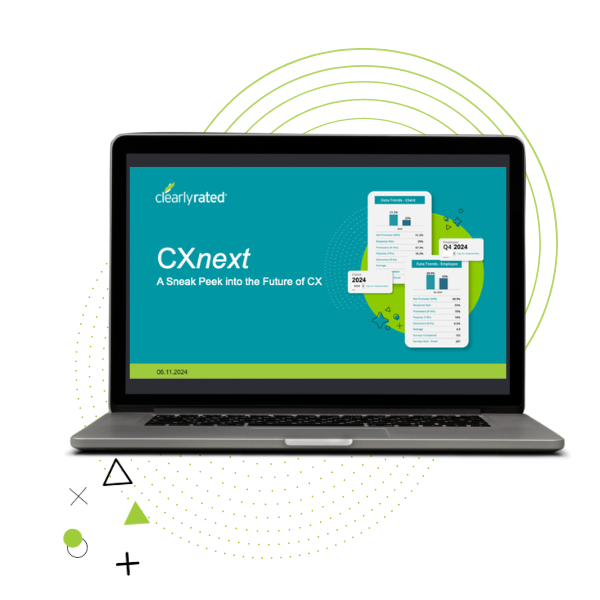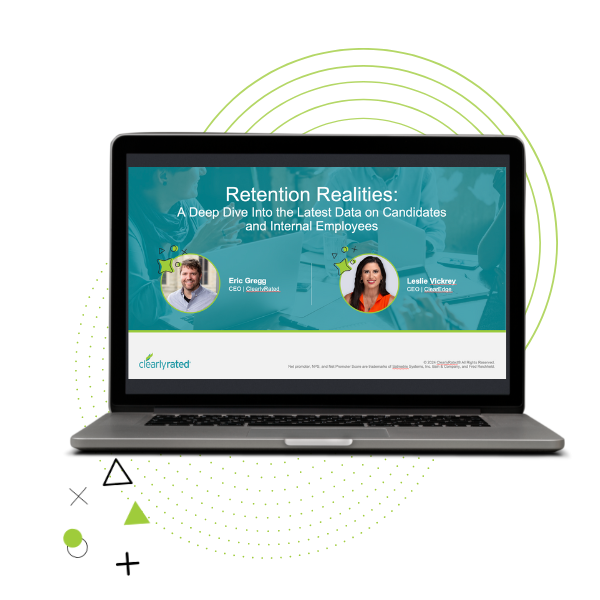My team at ClearlyRated spends a lot of time talking about client satisfaction and loyalty. We truly believe that for business service providers, the client experience (CX) must be at the heart of your business’ growth strategy. But in order for CX to inform business performance, it must be measured.
Measuring CX is the only way that you can actively manage and improve CX—which, for service providers, is the basis of your competitive differentiation. It’s why your clients buy from you in the first place, and why they stay with you for the long haul. Measuring the client experience can help you identify at-risk revenue and get ahead of costly client churn. It can help you understand your CX strengths and weaknesses. It can help you identify your happiest clients for potential referrals, testimonials, as well as cross-sell and upsell opportunities. And it can help you build your firm’s reputation with tangible proof of the experience you deliver.
3 Types of CX Measurement Methodologies
Surveys are the most common approach for gathering client feedback and for measuring the client experience. But within a survey, the question remains: What methodology should your firm use to measure CX? Here are 3 of the most common CX measurement methodologies utilized in business:
1. Customer Satisfaction Score (CSAT)
The CSAT metric requires customers to rate their satisfaction with your service, business, or product. The scale can vary, but we most commonly see this question asked on a 5-point scale.
2. Customer Effort Score (CES)
Most commonly implemented by business-to-consumer organizations, the CES is a metric that measures how much effort a customer must exert to get an issue resolved, a request fulfilled, a product purchased/returned or a question answered. CES surveys typically ask the question, “on a scale of ‘very easy’ to ‘very difficult’, how easy was it to interact with [company name].”
3. Net Promoter® Score (NPS®)
A widely adopted methodology for measuring customer loyalty, especially in business service firms, NPS measures your client’s willingness to recommend your firm to a friend or colleague on a scale from 0 to 10. All 3 of these methodologies deliver on the key benefits of a CX initiative. However, I am a huge advocate of the Net Promoter Score as an industry-best methodology for business service providers.

CX Best Practice for Business Service Firms: Why NPS Provides Outsized Benefits
From the way the question is designed, to the built-in benchmarking, NPS provides outsized benefits at scale for firms looking for a systematic way to measure the client experience. Here’s how:
- The framing of the question, which asks about a client’s willingness to refer rather than their subjective experience of satisfaction or effort, gets around bias and invites a more direct answer from your client. With NPS, you are essentially asking clients whether they would be willing to put their reputation on the line on behalf of your brand. What could be more direct than that?
- The fact that the question hinges on a willingness to refer connects directly to your firm’s most important source of new business: referrals. Not only does NPS provide insight into the health of your reputation among clients, but it also points you specifically to those clients that are ready to refer—opening new avenues for business development and revenue growth.
- The NPS methodology provides a clear rubric for interpreting client responses. Clients who respond with a 9 or 10 on the willingness to refer scale are considered Promoters—your happiest clients who you can (and should) work with to build reputation and earn new business. Clients who respond with a 7 or 8 are considered Passives—these clients are not actively unhappy but are identifying a “meh” experience that can be equally dangerous to your brand. Finally, clients who respond with a 0 to 6 are known as Detractors—these unhappy clients are speaking up to make their issues known. Detractors are offering you a lifeline, providing feedback so that you can resolve their concerns and elevate their experience before it’s too late.
- The “score” behind the Net Promoter Score provides valuable benchmarking to help you understand performance across teams, as well as within your industry at-large. The Net Promoter Score is calculated by subtracting the % of Detractors from the % of Promoters in your client base. We know from universal NPS standards that anything above a 50% NPS is considered “excellent,” anything above 70% is considered “world-class”. The NPS benchmark for insurance firms in 2022 is 42%—just above average and below excellent. These valuable benchmarks provide you with unprecedented context to evaluate your team’s performance. With NPS you can even segment scoring by team, by location, by market, or by individual performer—and apply these same benchmarks to create clarity and set goals.
- The frequency of surveying- Harvard Business Review recommends the question be asked throughout the buyer’s journey to get the most valuable and candid feedback. The frequency, however, will be dependent on the industry. Our team has research-backed knowledge in this area and can also share the estimated response rate based on the frequency of surveying.
Not convinced about the Net Promoter Score? Check out the blog post I wrote in response to a Wall Street Journal article back in 2019. It’s my “defense of NPS,” and addresses some common misconceptions and skepticisms about this powerful methodology. We also address everything NPS in our latest resource, Net Promotor Score® A Leading Metric to Business Success.






